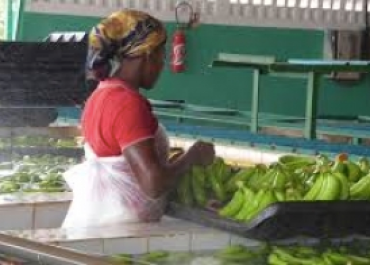
Afruibana reassured and reassured by the maintenance of the free movement of fruit with the EU
23 March 2020
“For bananas sold on the spot market, the situation is difficult.”
5 June 20203 questions to… Dieu Donné OKALAS OSSAMI, E-Tumba CEO.
What led you to develop this project? What objective have you set yourself through E-Tumba?
Today, in order to be accompanied in his daily production activity, the African farmer has a technical sheet (i.e. the “cotton” sheet, the “maize” sheet) combining his own references and those provided by the supervisory structures with which he is in contact (agribusinesses, agricultural companies, cooperatives, etc.). These data sheets correspond to ideal production situations, with no constraints in terms of labour, equipment, climate, finance and access to inputs.
In the end, they are more like standard guides or recommendations that are poorly adapted to the situation of each farmer and to the characteristics of a given year and each of his plots. Moreover, agricultural advice is most often based on these data sheets. It is aimed at thousands of farmers in a given production basin. Farm advisers are limited in number and must each address several hundred producers.
This standardised advice format through technical data sheets is encountering difficulties in terms of relevance, particularly on climate risk issues. Likewise, all tools based on these fact sheets observe de facto difficulties in terms of adoption for three main reasons :
– the information is too general, based on technical data sheets and “best practices” that are not always adapted to the individual situation of each farmer
– the change of scale: the agricultural advice provided is developed by agricultural technicians in too limited a number to follow millions of smallholders
– the cost
It therefore appeared to us that this highly standardised advice format was not sufficiently precise and adapted to the issues at stake on each farm, thus contributing to a stagnation in yields and productivity, as a result of which agricultural activity has little knock-on effect on economic growth.
It is on the strength of this observation and in order to provide a concrete response to these difficulties that I created E-Tumba. With individualized advice, specific to the particularities of each cultivated plot, and generated on the basis of models, the solution developed by E-Tumba removes the difficulties of information relevance and change of scale. Finally, as the implementation of the models is centralised, costs are reduced.
With E-Tumba, I have set myself the objective of contributing to the digital transition of agricultural advisory services in Africa and the professionalization of small farmers by facilitating their integration into agri-food value chains.

In your opinion, what are the most important levers for improving African agricultural practices today and how does E-Tumba fit into this approach?
For me, the improvement of African agricultural practices involves 2 main levers. Technical training must be developed by involving companies in defining curricula and skills. It is also clear that a better structuring of the sectors, “from farm to fork”, is necessary. This can be achieved by contracting upstream the technical, commercial and financial relations between small farmers and agribusinesses and by developing “origins” and “controlled or protected designations” in order to structure and facilitate access to downstream markets.
E-tumba is part of this approach by following a co-construction of expertise approach; the tools developed by E-tumba are the result of a joint work between farmers, local support structures and the expertise of agro-industrials. They are based on needs and not on supply. As a result, they can be adapted to the needs of each link in the value chain and improved on a regular basis.
What are the feedback from the beneficiaries? What obstacles do you encounter regarding the deployment of your solution and what do you put in place about it?
The obstacles in the deployment of the e-Tumba solution are mainly related to :
– the too great diversity of farmers which obliges to take into account the level of technicality, the level of education, the means of production of each farmer, etc.
– the geographical spread of farmers over often very large territories, thus making census operations difficult,
– the non-existence of land tenure in some countries, which obliges seasonal validation of cultivated areas to better determine the quantities of inputs needed to be distributed per plot.
– The limited internet connection in some territories.
In order to provide individualized advice, all these factors are taken into account by the E-tumba solution.
So far, the feedback from the main beneficiaries has been very positive as the solution allows overall performance to be improved on several levels.
Indeed, our system allows producers to :
– to optimize yields while meeting environmental challenges
– achieve direct input savings thanks to a precise diagnosis of plant needs, increased by the rise in market prices
– to organize field interventions, thanks to alerts and timely recommendations
– to benefit from the advice of an expert agronomic council to optimise quality and respect for the environment Before any deployment of the solution, it is easy to get to grips with it by training local players in the field and providing local support throughout the season. We always start with a pilot project on a limited, but significant sample before any deployment on a larger scale. This allows us to better calibrate the solution to the specific production context of the target partner.




